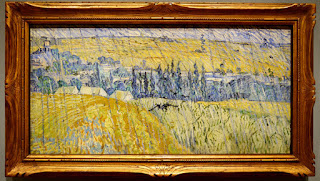VAN GOGH IN NATURE
(Also Whistler's Mother)
Sterling and Francine
Clark Art Gallery
Williamstown, MA
Through September 13
(9/27 for Whistler)
 |
| Early homage to Millet |
 |
| The red anchor |
They are, as the title implies, works that explore Van
Gogh's relationship to nature. Being that it's Van Gogh, that relationship was
complicated. He simultaneously felt more peace amidst nature than anywhere
else, yet was so overwhelmed by it that bald mountains, fecund fields, and
majestic cypress trees made him feel unworthy and were another nail in the
self-built depression coffin that led to his suicide at age 37. But what a
glorious 37 years they were. The Clark exhibit shows Van Gogh's evolution as a
painter who first drew inspiration from Daubigny and Millet—check out Van
Gogh's homage to Millet's The Sower—to
one whose unique style only fully emerged in nature. It began with drawings and
oils of a marsh executed in 1881, then we see his palette come alive with color
when he
moved from the somber Dutch countryside to France—first to Paris, but
with full vibrancy in the countryside (Arles, the asylum grounds of Saint-Rémy,
and Auvers-sur-Oise). That vibrancy extends to subtle things, such as the way Van
Gogh often used a splash of red to anchor his work and forced the viewer's eye
to roam where he wished.  |
| Early spring or late snow? |
It wasn't the only psychological game he played. We see an orchard awash in white, but it's an April scene and the only reason we have to see blossoms rather than a late snow is our knowledge of the Provence climate. We view farmhouses in Auvers, but we only know that the winding blue course disappearing around a tree is a country lane rather than a stream because there's a solitary figure trudging down it. For those who want to psychoanalyze even more, as a youth Van Gogh painted variations of Millet's The Sower, but as he entered his mid-30s, sickle-wielding reapers more often appear. Ahh, that line between genius and madness. From May 1889 to May 1890, Van Gogh was in an asylum, but it was also his most fertile period—one in which he created a new work nearly every other day. He left Saint-Rémy to be near his brother in Auvers and created a stunning oil unlike others, Landscape at Auvers in the Rain in July of 1890, and was dead before the month ended. [See image below]
 |
| Auvers in the Rain |
Also on exhibit at the Clark's airy Stone Hill Center is
James McNeill Whistler's iconic 1871 painting Arrangement in Grey and Black No.1, better known to posterity as Whistler's Mother. There is also a small
collection of Whistler etchings and prints, but the painting is the big
attraction. The pocket-sized show also tells the tale of how the painting,
which yielded mixed to scathing reviews when first executed, became famous
(after 1932, nearly 30 years after Whistler's death). There are also a few
choice parodies of the work. The biggest attraction of all is that as remote as
Williamstown, Massachusetts might be, it's cheaper to get there than to fly to
Paris to see Whistler's famed work in its permanent home, the Musée d'Orsay.
I'll grant you that a trip to Paris has side virtues, but you won't need a passport
if you get to the Berkshires before September 27. Rob Weir
 |
| The blue path. Note red roof. |



1 comment:
Yep
Post a Comment